
The city of Rome was etched in my heart when Audrey Hepburn enchanted me as a young princess. She escaped the royal life for a day of adventure with Gregory Peck in the Hollywood movie “A Roman Holiday.”
Sightseeing on Roman Holiday
As we stroll through its ancient streets, the city of Rome unravels layers and layers of history like a palimpsest, transporting us back in time. The city has existed across different periods – ancient Republican, imperial, medieval, Renaissance and modern. It symbolized the inner structure of the human mind for the psychologist Sigmund Freud. To the historian, it is “Roma Aeterna or the eternal city”. It evokes images of a glorious classical past of the European civilization. To the pilgrim, it is the center of the Christian world and the Roman Catholic Church as it encloses the independent state of the Vatican.
The foundation of Rome
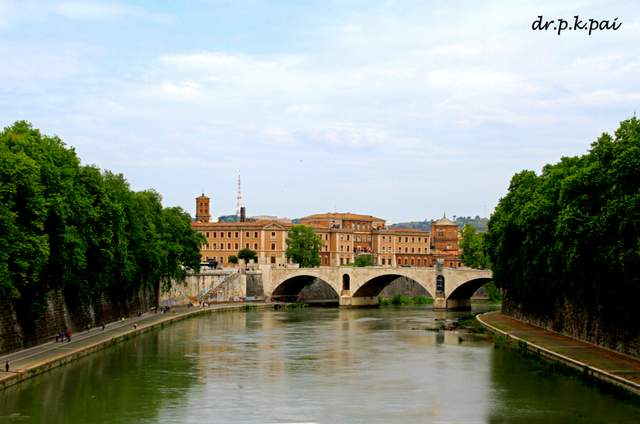
The Tiber river snakes through the city whose earliest settlements grew on the seven hills that dot the eastern side of the river. Roman poets such as Virgil, Horace, and Ovid emphasized the primacy of these seven hills as a political and sacred focal point for “Roma Aeterna” during its development. Across the river, on its western side, lies the elevated land of the Vatican. The Vatican, of course, draws millions of pilgrims and tourists every year. The ruins and monuments of ancient and imperial Rome lie mainly to the east of the river. The muraglio or thick embankments of travertine rock built along the river in the 19th century protect the city from flooding.
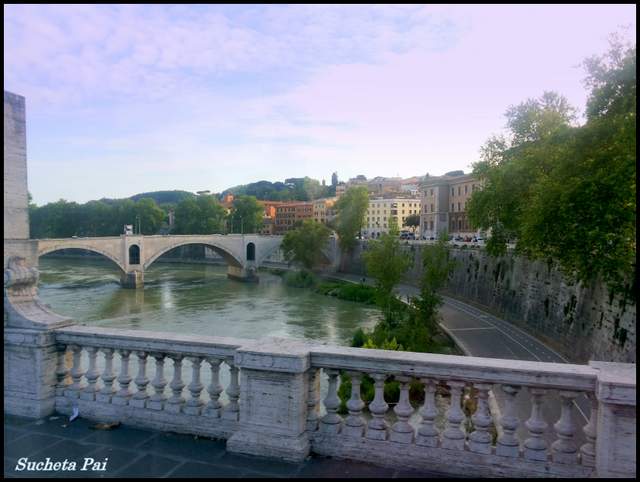
Myth of Birth
The Palatine hill is the geographical heart of Rome around which the city grew. The foundation myth of Rome credits a pair of twins –Romulus and Remus-for founding the city. It is here in the “Lupercal” (cave of wolf) that the twins of Mars and Rhea who were abandoned on the Tiber were nurtured by a she-wolf and raised by a shepherd. According to this legend, they later went on to become the founders of Rome but a quarrel between them resulted in the slaying of Remus by his brother.
Rome the City of Fountains
Rome is a city of piazzas (large town squares) and Fontana’s (fountain). The large open squares characteristic of European cities are centers of social life where people meet, share experiences and forge bonds. They symbolize the culture, heritage, and identity of the community and foster a sense of belonging to its citizens. Decorative fountains often adorn the piazzas of Rome reinforcing the soothing power of water in Roman life. Moving around the city, we pass through so many piazzas and fountains that we lose count of them!
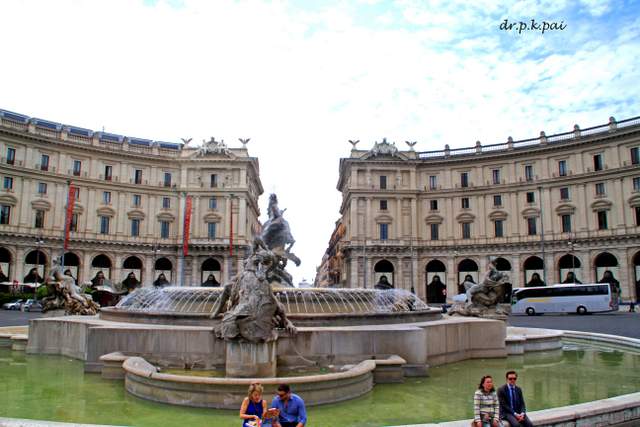
Fontana di Trevi
We began our tour of Rome by walking to the largest sculpture of Baroque art in the world – Fontana di Trevi. Yes, it is the same fountain that was immortalized by Federico Fellini in his film “La Dolce Vita”. This fountain was cleaned and restored by the designer house Lendi in 2015. As one approaches the Piazza di Trevi, the sound of the gushing water grows louder. The narrow street with its red brick buildings –via del Lavatore- dramatically opens out into a large space with a spectacular fountain which nestles in the junction of three roads or trevie. The imposing marble palace Palazzo Poli forms the backdrop. The curved rows of seats in front of the fountain give it a theatrical touch.
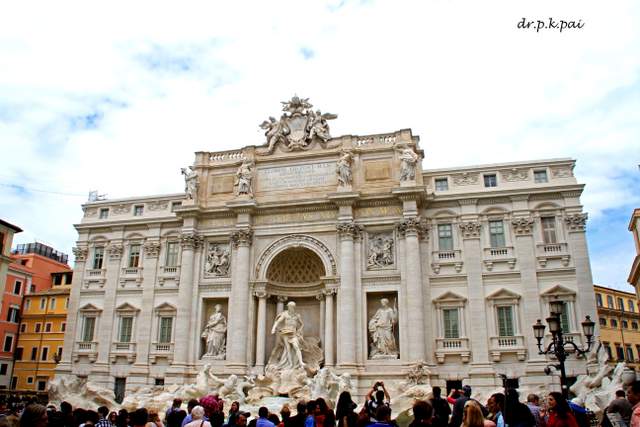
In ancient times, this was the terminal point for Aqua Virgo, the aqueduct built by Augustus to provide water for the thermal baths. According to legend, thirsty Roman soldiers were led to this spring by a young roman girl. In the 18th century, Pope Clement XIII commissioned its restoration to the Italian designer Nicola Salvi. It was completed by Pietro Bracci.
Oceanus
The central figure is the bearded Oceanus. He is the powerful god of the seas, standing astride a chariot in the shape of a shell. Tritons control the hippocampus or mythical sea-horses which burst out of the fountain symbolizing the waves, the rough and the calm waters of the sea. Different species of plants are carved on the marble rocks which seem to merge seamlessly into the water creating a sense of movement. Allegorical figures of Abundance holding the cornucopia (the horn of plenty) and Health holding a cup from which a snake drinks, are sculpted in the niches on either side of Oceanus.

According to tradition, throwing a coin into the fountain over one’s right shoulder ensures a revisit to Rome. Throwing two coins will mean a new romantic person in your life! Throwing three coins will lead to marriage!
Altare Della Patria
Piazza Venezia is the central hub of Rome. Here an imposing monument of unified Italy rises as an ‘Altar to the Fatherland.’ Called “Il Vittoriano” it is dedicated to the first king of unified Italy Vittorio Emanuele II. Built with sparkling white Brescian marble instead of the beige travertine stone used in traditional Roman monuments, it was called “la macchina da scrivere” (the typewriter) by the American soldiers marching through Rome in 1944. It also earned the nickname “la torta nuziale” (the wedding cake) because of its appearance! Designed by Guiseppe Sacconi in 1885 it was completed after four decades. A medieval village with the Papal villa and fortifications on the Capitoline hill were razed to the ground to raise this gigantic structure symbolizing Italian solidarity under the imperialist regime.

At the bottom level is the central figure of Dea Roma clad in the traditional Roman toga with processions of Italian citizens flanking her on both sides. The Tomb of the Unknown Soldier with an eternal flame lies beneath the statue of the pagan goddess. An equestrian statue of Victor Emmanuel II dominates the second level as a personification of the Risorgimento or the resurrection of the new Italian state. The huge Corinthian columns of the monument imitate the past glories of ancient Rome. Two statues of goddess Victoria riding on quadrigas (chariots drawn by four horses) are perched atop the building. Under the fascist rule of Mussolini, this grandiose monument became the site for rallies, speeches and triumphal marches promoting his neo-imperialistic agenda.
The Colosseum visit during our Roman Holiday
Perhaps no other structure represents Roman power than this vast gladiatorial arena called The Colosseum. It was built by slaves brought from the sacking of Jerusalem by Emperor Vespasian. The invention of concrete by mixing the volcanic material pozzolana with sand, lime and rubble helped to accelerate the pace of construction. This oval Flavian amphitheater was inaugurated by his son Titus in 80 CE. Gory games that lasted for hundred days were held here. Gladiators fought lions and other wild animals while the crowd roared at the bloody combats!
Etymology & Architecture of Colosseum
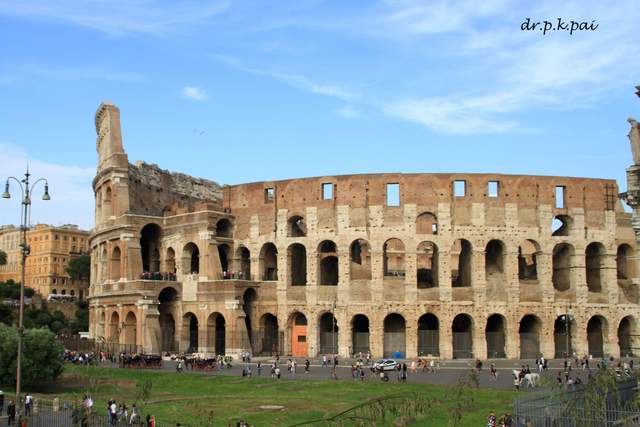
The Colosseum or Coliseum gets its name from a giant statue of Nero or ‘Colosso di Nerone’. Vespasian built the amphitheater on the site of Nero’s palace. The structure has three stories of arched entrances supported by Ionic, Doric and Corinthian columns. A fourth-story has rectangular windows. An underground ‘hypogeum’ beneath the arena housed caged animals used in gladiatorial fights. There were 80 entrances known as ‘vomitoria’ so that huge crowds could be evacuated in 15 minutes! The arena was encircled by a three-tiered seating area called ‘cavea’ with numbered seats. It could hold more than 50,000 people at a time! A huge awning or ‘velarium’ held by masts protected the spectators from sun and rain.

With the fall of the Roman Empire in the 5th century AD, the Colosseum was abandoned and plundered. The marble was quarried and used to build huge palaces and churches including St.Peter’s Cathedral. Weather and natural disasters like earthquake and lightning destroyed a large part of the structure. But restoration efforts began in the 18th century making it an iconic symbol of Rome for tourists from all over the world.
To be continued – read part ii

For me, writing is a form of travel which allows me to journey out of my little world of everyday routine. Writing is also an inward journey which deepens my understanding of the places that I have visited and appreciate the diversity of different cultures. It’s like the music which I learned as a child. It gives wings to my imagination and nourishes my soul. My passion for reading led me to do my post graduation in English literature from Mysore University. After working as a lecturer for a brief period, I became a homemaker. It gives me space and time to do the things I love most – music, reading, surfing the net to learn about the things I do not know.
Recommended travel blogs on European Tourist attractions.
Walk around Dresden old town, Things to do in Dresden, Germany
Walking around Prague Castle, Czech Republic
Handsome Parliament of Hungary, Budapest
Wieliczka Salt Mine, Krakow, Poland – A UNESCO World Heritage Site














They say Rome was not built in a day. I say, Rome cannot be seen in a day! In fact, even a week is not enough…there are sights to see at every inch!
Rome is right on top of my wish list – let’s see when do I get a chance to visit it. At the moment I can see – hope to see it one day.
Rome is just amazing. My highlight of this city was the Colosseum. I absolutely loved my tour of the interiors of the Colosseum. Vatican too is just amazing.
Tempt me as much as you can Ami 🙂
Rome is such a beautiful place ..Can’t wait to visit next year 🙂 Have bookmarked this page
I hope to visit it at leisure sometime. This is one place I can live for a while.
benvenuto, Rome is a beautiful place, glad you deceided to Visit us. if around tuscany do visit us, we run a Bed and Breakfast here , special service for our Indian Friend 🙂
I hope to visit Italy sometime – the stars have not yet aligned for that journey.
Thanks for sharing a great post!
And the images are beautiful…
very good..appreciative..write more
Thanks for sharing the information, I got to know how beautiful Rome is…..